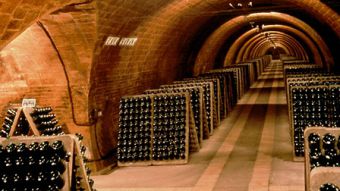From France with love: Belondrade y Lurton
Having fallen in love with the Verdejo grape variety, Didier Belondrade, a director at Air France, flew down to Valladolid, bought some vines and opened a model winery in the 90s. His Belondrade y Lurton is THE fine wine from Rueda, representing excellence in the region. Since that time, fine Verdejo has become synonymous with Belondrade.
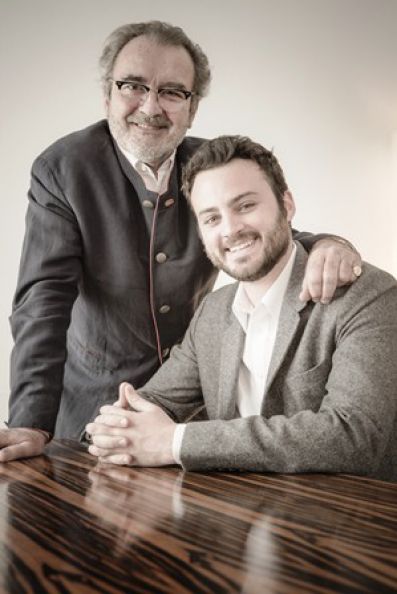 Didier and Jean Belondrade Didier Belondrade first tasted the wine from Rueda when he happened to be in Spain around 25 years ago and it was a revelation, love at first taste. He was working for Air France at the time and, because of his senior position and everything that goes with it, he was already something of a wine connoisseur. He particularly enjoyed the wines produced in his home country, especially the fine white wines from Burgundy and the Loire Valley. He immediately started thinking about the feasibility of creating a great Spanish white wine made exclusively from the Verdejo grape and he resolved to make it happen. He started by visiting the Castilian plateau to get to know the area. He then rented an industrial warehouse in Nava del Rey, which is not exactly the most picturesque village and nothing at all like the lovely, bucolic French landscapes to which he was accustomed, which makes his project all the more praiseworthy. Turning the warehouse into a rudimentary winery, he began buying grapes from local growers and in ‘96 his first new Belondrade y Lurton ‘94 was released, selling at a price much higher than the other Ruedas available on the market at the time (around 900 pesetas, compared to an average of 150 pesetas) and boasting a significantly longer crianza, exceeding 12 months.
Didier and Jean Belondrade Didier Belondrade first tasted the wine from Rueda when he happened to be in Spain around 25 years ago and it was a revelation, love at first taste. He was working for Air France at the time and, because of his senior position and everything that goes with it, he was already something of a wine connoisseur. He particularly enjoyed the wines produced in his home country, especially the fine white wines from Burgundy and the Loire Valley. He immediately started thinking about the feasibility of creating a great Spanish white wine made exclusively from the Verdejo grape and he resolved to make it happen. He started by visiting the Castilian plateau to get to know the area. He then rented an industrial warehouse in Nava del Rey, which is not exactly the most picturesque village and nothing at all like the lovely, bucolic French landscapes to which he was accustomed, which makes his project all the more praiseworthy. Turning the warehouse into a rudimentary winery, he began buying grapes from local growers and in ‘96 his first new Belondrade y Lurton ‘94 was released, selling at a price much higher than the other Ruedas available on the market at the time (around 900 pesetas, compared to an average of 150 pesetas) and boasting a significantly longer crianza, exceeding 12 months.
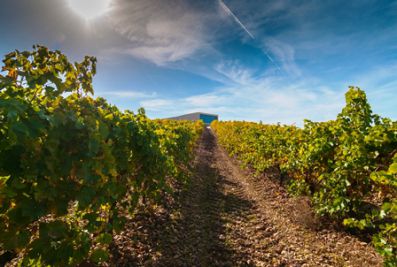 From the outset, it clearly stood out from the crowd and instantly acquired a special aura. It caught the attention of the most important influencers and sommeliers in Spain (Quim Vilas, Alfred Peris of El Bulli, etc.). Married at the time to Brigitte Lurton, from the famous Bordeaux wine family, owners and makers of great châteaux wines, Didier knew his wines and what he was after. In order to manage his winemaking activity in parallel to his position at Air France, and since he had no training in winemaking or agronomy, he brought in professionals to handle this side of the business. He began the construction of a winery in La Seca, surrounded by the vines that he went about acquiring plot by plot. Not long afterwards, he quit his job at Air France and moved to Valladolid to devote himself, body and soul, to his wine. His was a true love affair with the Verdejo, not to mention a major change of life! With Marta Baquerizo, his winemaker and right hand (wo)man, whom he refers to as his “conscience”, he expanded the winery and vineyards, and has recently added two new vineyard plots to his more than 30 hectares.
From the outset, it clearly stood out from the crowd and instantly acquired a special aura. It caught the attention of the most important influencers and sommeliers in Spain (Quim Vilas, Alfred Peris of El Bulli, etc.). Married at the time to Brigitte Lurton, from the famous Bordeaux wine family, owners and makers of great châteaux wines, Didier knew his wines and what he was after. In order to manage his winemaking activity in parallel to his position at Air France, and since he had no training in winemaking or agronomy, he brought in professionals to handle this side of the business. He began the construction of a winery in La Seca, surrounded by the vines that he went about acquiring plot by plot. Not long afterwards, he quit his job at Air France and moved to Valladolid to devote himself, body and soul, to his wine. His was a true love affair with the Verdejo, not to mention a major change of life! With Marta Baquerizo, his winemaker and right hand (wo)man, whom he refers to as his “conscience”, he expanded the winery and vineyards, and has recently added two new vineyard plots to his more than 30 hectares.
HARMONY AND GOOD TASTE
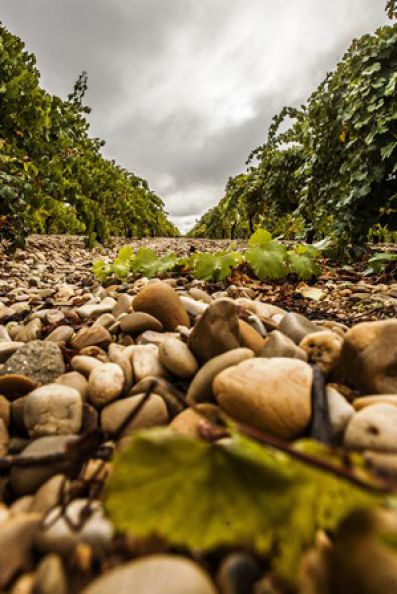 Quinta San Diego, which is the name of the ensemble that today comprises the vineyards, winery and cellars, is an ode to good taste and harmony, which you can sense the moment you set foot on the estate. Without doubt, it reflects the personality of its owner, who is as passionate about the Verdejo as he is about modern art or music. His is a well-designed, showcase winery that perfectly expresses the quality and depth of his Belondrade y Lurton wines. Its name is a tribute to one of his sons, Diego, who died at a young age. His three other children are also very much part of the project. There is Jean, who works full time in the business and who will succeed his father at some point in the future, and Apolonia, who lent her name to the other white wine released on the market in 2002 (Quinta Apolonia). Didier also produces a very special rosé made with grapes from the estate’s only plot of Tempranillo. He had been thinking about grubbing up this red grape variety, but instead decided to make a rosé from the grapes. In light of its success, and particularly at the insistence of his daughter, Clarisa, he decided to name the wine Quinta Clarisa. This rosé spends around two months on its fine lees in the barrels used for the Quinta Apolonia.
Quinta San Diego, which is the name of the ensemble that today comprises the vineyards, winery and cellars, is an ode to good taste and harmony, which you can sense the moment you set foot on the estate. Without doubt, it reflects the personality of its owner, who is as passionate about the Verdejo as he is about modern art or music. His is a well-designed, showcase winery that perfectly expresses the quality and depth of his Belondrade y Lurton wines. Its name is a tribute to one of his sons, Diego, who died at a young age. His three other children are also very much part of the project. There is Jean, who works full time in the business and who will succeed his father at some point in the future, and Apolonia, who lent her name to the other white wine released on the market in 2002 (Quinta Apolonia). Didier also produces a very special rosé made with grapes from the estate’s only plot of Tempranillo. He had been thinking about grubbing up this red grape variety, but instead decided to make a rosé from the grapes. In light of its success, and particularly at the insistence of his daughter, Clarisa, he decided to name the wine Quinta Clarisa. This rosé spends around two months on its fine lees in the barrels used for the Quinta Apolonia.
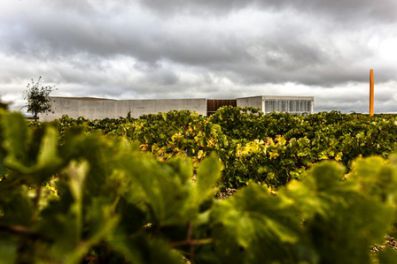 The ageing cellar is spectacular in terms of its beauty and design and is a real education in barrel ageing. In this cellar the wood is treated with textbook care and attention. Although the wines are Verdejo single varietals, and despite the fact that Didier is French, he has no interest in the Sauvignon Blanc, which is becoming increasingly popular in the region (he says it is perfect for regions such as the Loire, but not for the Castilian plateau). His wines are very sophisticated and finely crafted. True assemblages. About 300 barrels are housed in this beautiful ageing cellar, with different types of wood and toasting, into which the grapes from the 20 vineyard plots are introduced and fermented separately. There are barrels from a number of different cooperages: Vidard, Silvain, Dargaud Jaergle... the variety is just extraordinary. The barrels will do their work up until the time when, some months later, the team carries out an exhaustive tasting of each and every one of the barrels to identify the 15 batches that will be used to craft the perfect blend for the Belondrade y Lurton. The others will go into Quinta Apolonia. Incredible work and a tasting exercise unlike any other.
The ageing cellar is spectacular in terms of its beauty and design and is a real education in barrel ageing. In this cellar the wood is treated with textbook care and attention. Although the wines are Verdejo single varietals, and despite the fact that Didier is French, he has no interest in the Sauvignon Blanc, which is becoming increasingly popular in the region (he says it is perfect for regions such as the Loire, but not for the Castilian plateau). His wines are very sophisticated and finely crafted. True assemblages. About 300 barrels are housed in this beautiful ageing cellar, with different types of wood and toasting, into which the grapes from the 20 vineyard plots are introduced and fermented separately. There are barrels from a number of different cooperages: Vidard, Silvain, Dargaud Jaergle... the variety is just extraordinary. The barrels will do their work up until the time when, some months later, the team carries out an exhaustive tasting of each and every one of the barrels to identify the 15 batches that will be used to craft the perfect blend for the Belondrade y Lurton. The others will go into Quinta Apolonia. Incredible work and a tasting exercise unlike any other.
NO TO SINGLE VINEYARD WINES
After the wood ageing, the wines rest in the bottle for a minimum of six months in order to round out and continue their development in bottle after reaching their final destination. Tasting the old vintages, with many years’ bottle ageing (if you can get hold of any, that is) is an almost religious experience. These white wines attain an admirable degree of elegance and complexity, on a par with the great French whites. The decision to attempt to turn Rueda into a kind of Spanish white Burgundy has clearly paid off for his brand and reputation.
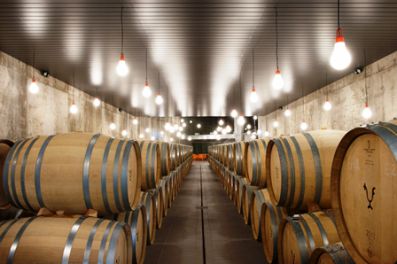 Didier has not yet succumbed to the temptation to make a single vineyard wine, despite the quality he encounters in some of the plots and barrels. He insists that he came to Rueda to make fine white wines from the Verdejo, under the one brand name, and he is sticking to his objective, which is highly commendable, particularly when you consider that the fashion today is for micro-productions from small vineyard plots. If you take into account the fact that, after a long, meticulous process of assemblage, 108,000 bottles of the latest Belondrade y Lurton vintage (the 2015), and 55,000 of Quinta Apolonia, have been released on the market, it is easy to imagine the difficulty of the selection. But his approach pays off as the wines are already sold before they are even released.
Didier has not yet succumbed to the temptation to make a single vineyard wine, despite the quality he encounters in some of the plots and barrels. He insists that he came to Rueda to make fine white wines from the Verdejo, under the one brand name, and he is sticking to his objective, which is highly commendable, particularly when you consider that the fashion today is for micro-productions from small vineyard plots. If you take into account the fact that, after a long, meticulous process of assemblage, 108,000 bottles of the latest Belondrade y Lurton vintage (the 2015), and 55,000 of Quinta Apolonia, have been released on the market, it is easy to imagine the difficulty of the selection. But his approach pays off as the wines are already sold before they are even released.
Two years ago, Didier, a perfectionist with a keen and enquiring mind and his great friend, Gonzalo Cores, acquired a magnificent 4-hectare plot of old vines in the Priorat. Right now he is considering whether to produce a red wine on a par with Priorat’s finest, as per his philosophy. But he is taking things slow. He is in no hurry. For now, the red can wait. He is still considering Galicia for his next big, white hit.








